Workplace Violence Among UK Nursing Students
VerifiedAdded on 2023/04/03
|8
|1488
|199
AI Summary
This article examines the scope and nature of workplace violence among UK nursing students during their placement program. It discusses the impact of workplace violence on students' future career development and provides strategies for universities to address the issue. The study involved 657 participants and highlights the need for a collaborative approach between universities and clinical providers. The article also emphasizes the importance of a fair representation of the sample population and ethical considerations in research.
Contribute Materials
Your contribution can guide someone’s learning journey. Share your
documents today.

0
ADVANCED CRITICAL THINKING
Student’s Name
Advanced Critical Thinking
Course Studied
Course Code
State
City
Date
ADVANCED CRITICAL THINKING
Student’s Name
Advanced Critical Thinking
Course Studied
Course Code
State
City
Date
Secure Best Marks with AI Grader
Need help grading? Try our AI Grader for instant feedback on your assignments.
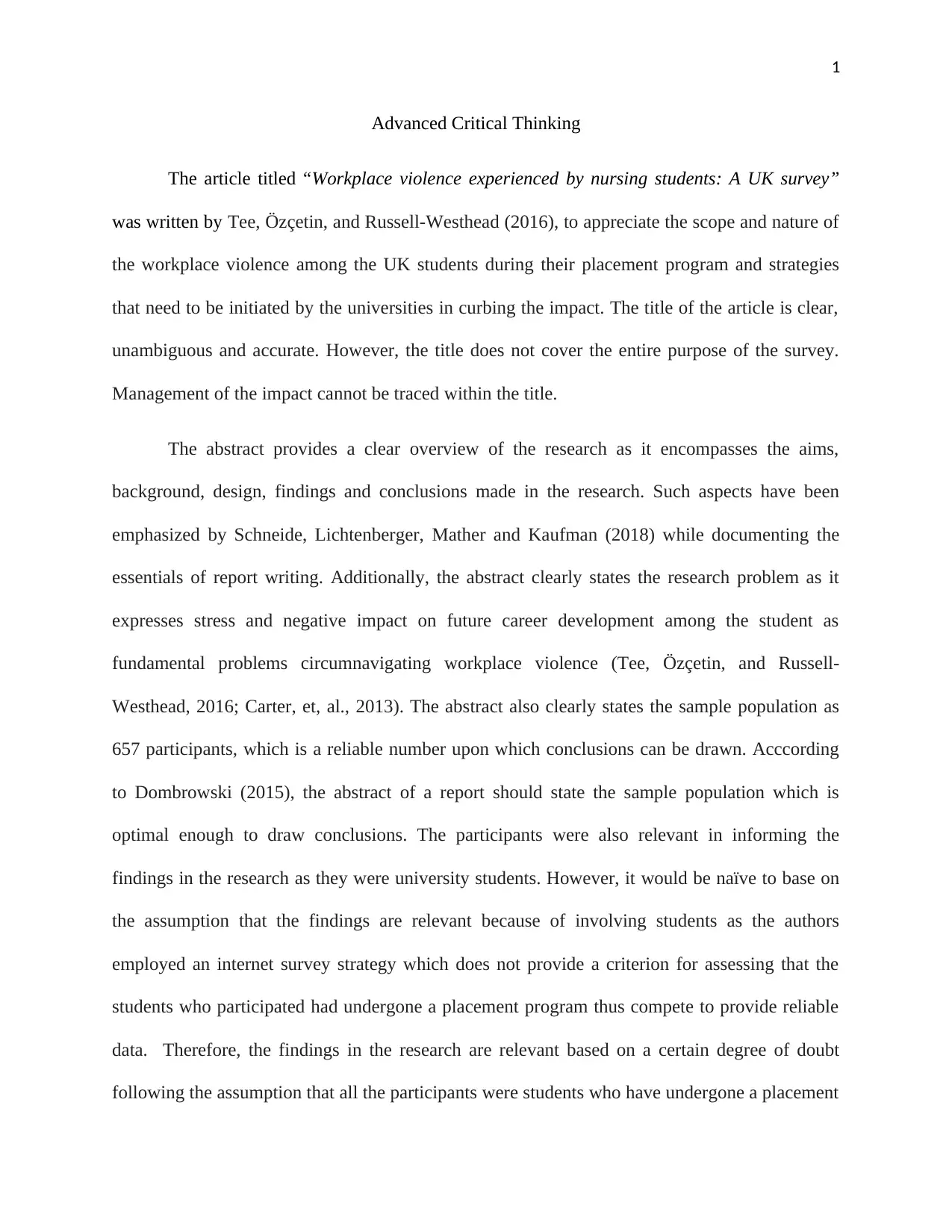
1
Advanced Critical Thinking
The article titled “Workplace violence experienced by nursing students: A UK survey”
was written by Tee, Özçetin, and Russell-Westhead (2016), to appreciate the scope and nature of
the workplace violence among the UK students during their placement program and strategies
that need to be initiated by the universities in curbing the impact. The title of the article is clear,
unambiguous and accurate. However, the title does not cover the entire purpose of the survey.
Management of the impact cannot be traced within the title.
The abstract provides a clear overview of the research as it encompasses the aims,
background, design, findings and conclusions made in the research. Such aspects have been
emphasized by Schneide, Lichtenberger, Mather and Kaufman (2018) while documenting the
essentials of report writing. Additionally, the abstract clearly states the research problem as it
expresses stress and negative impact on future career development among the student as
fundamental problems circumnavigating workplace violence (Tee, Özçetin, and Russell-
Westhead, 2016; Carter, et, al., 2013). The abstract also clearly states the sample population as
657 participants, which is a reliable number upon which conclusions can be drawn. Acccording
to Dombrowski (2015), the abstract of a report should state the sample population which is
optimal enough to draw conclusions. The participants were also relevant in informing the
findings in the research as they were university students. However, it would be naïve to base on
the assumption that the findings are relevant because of involving students as the authors
employed an internet survey strategy which does not provide a criterion for assessing that the
students who participated had undergone a placement program thus compete to provide reliable
data. Therefore, the findings in the research are relevant based on a certain degree of doubt
following the assumption that all the participants were students who have undergone a placement
Advanced Critical Thinking
The article titled “Workplace violence experienced by nursing students: A UK survey”
was written by Tee, Özçetin, and Russell-Westhead (2016), to appreciate the scope and nature of
the workplace violence among the UK students during their placement program and strategies
that need to be initiated by the universities in curbing the impact. The title of the article is clear,
unambiguous and accurate. However, the title does not cover the entire purpose of the survey.
Management of the impact cannot be traced within the title.
The abstract provides a clear overview of the research as it encompasses the aims,
background, design, findings and conclusions made in the research. Such aspects have been
emphasized by Schneide, Lichtenberger, Mather and Kaufman (2018) while documenting the
essentials of report writing. Additionally, the abstract clearly states the research problem as it
expresses stress and negative impact on future career development among the student as
fundamental problems circumnavigating workplace violence (Tee, Özçetin, and Russell-
Westhead, 2016; Carter, et, al., 2013). The abstract also clearly states the sample population as
657 participants, which is a reliable number upon which conclusions can be drawn. Acccording
to Dombrowski (2015), the abstract of a report should state the sample population which is
optimal enough to draw conclusions. The participants were also relevant in informing the
findings in the research as they were university students. However, it would be naïve to base on
the assumption that the findings are relevant because of involving students as the authors
employed an internet survey strategy which does not provide a criterion for assessing that the
students who participated had undergone a placement program thus compete to provide reliable
data. Therefore, the findings in the research are relevant based on a certain degree of doubt
following the assumption that all the participants were students who have undergone a placement

2
program. Furthermore, there existed a huge gender bias in the sample population. The sample
population should be a fair representation of the entire population (Pyrczak, 2016). Most of the
respondents were ladies (88.3%) (Tee, Özçetin, and Russell-Westhead, 2016). It is clear that the
rate of bullying among women is not the same as that in men thus such research should empress
equality in the sample population in order to get a clear scope and nature of the workplace
violence. Most importantly, the abstract provides recommendations which suggest a
collaborative approach between the universities and clinical providers in the management of
workplace violence among the students.
The article has an introduction which is clear intensively explore the definition of key
terms with respect to the topic. However, the introduction is adequately referenced, which is a
breach of the terms and conditions of report writing (Stichler, 2014). The article lacks a literature
review which a necessity for a good research (Neuman, & Robson, 2014). However, the views of
diverse authors, as presented in different pieces of literature on the topic, have been fully
included ethically referenced in the introduction and background sections of the article. The
study uses a survey strategy which is relevant as it is an objective method of data collection
(Schoenherr, Ellram, and Tate, 2015; McPeake, Bateson, and O’Neill, 2014). The research method
has been clearly defined and explained. However, the authors do not present the reasons for
choosing a survey against other methods of research as a necessity in report writing (Beck,
2009). The philosophical underpinnings of the approach have been adequately explored. For
instance, the article states that the approach was tested and approved by Hewett in 2010. Data
analysis involved coding of the information and analysis using a computer-based data
management system. After then, the information was exported to an SSPSS 21 statistical
software before making use of percentages and figures in the presentations depending on data
program. Furthermore, there existed a huge gender bias in the sample population. The sample
population should be a fair representation of the entire population (Pyrczak, 2016). Most of the
respondents were ladies (88.3%) (Tee, Özçetin, and Russell-Westhead, 2016). It is clear that the
rate of bullying among women is not the same as that in men thus such research should empress
equality in the sample population in order to get a clear scope and nature of the workplace
violence. Most importantly, the abstract provides recommendations which suggest a
collaborative approach between the universities and clinical providers in the management of
workplace violence among the students.
The article has an introduction which is clear intensively explore the definition of key
terms with respect to the topic. However, the introduction is adequately referenced, which is a
breach of the terms and conditions of report writing (Stichler, 2014). The article lacks a literature
review which a necessity for a good research (Neuman, & Robson, 2014). However, the views of
diverse authors, as presented in different pieces of literature on the topic, have been fully
included ethically referenced in the introduction and background sections of the article. The
study uses a survey strategy which is relevant as it is an objective method of data collection
(Schoenherr, Ellram, and Tate, 2015; McPeake, Bateson, and O’Neill, 2014). The research method
has been clearly defined and explained. However, the authors do not present the reasons for
choosing a survey against other methods of research as a necessity in report writing (Beck,
2009). The philosophical underpinnings of the approach have been adequately explored. For
instance, the article states that the approach was tested and approved by Hewett in 2010. Data
analysis involved coding of the information and analysis using a computer-based data
management system. After then, the information was exported to an SSPSS 21 statistical
software before making use of percentages and figures in the presentations depending on data
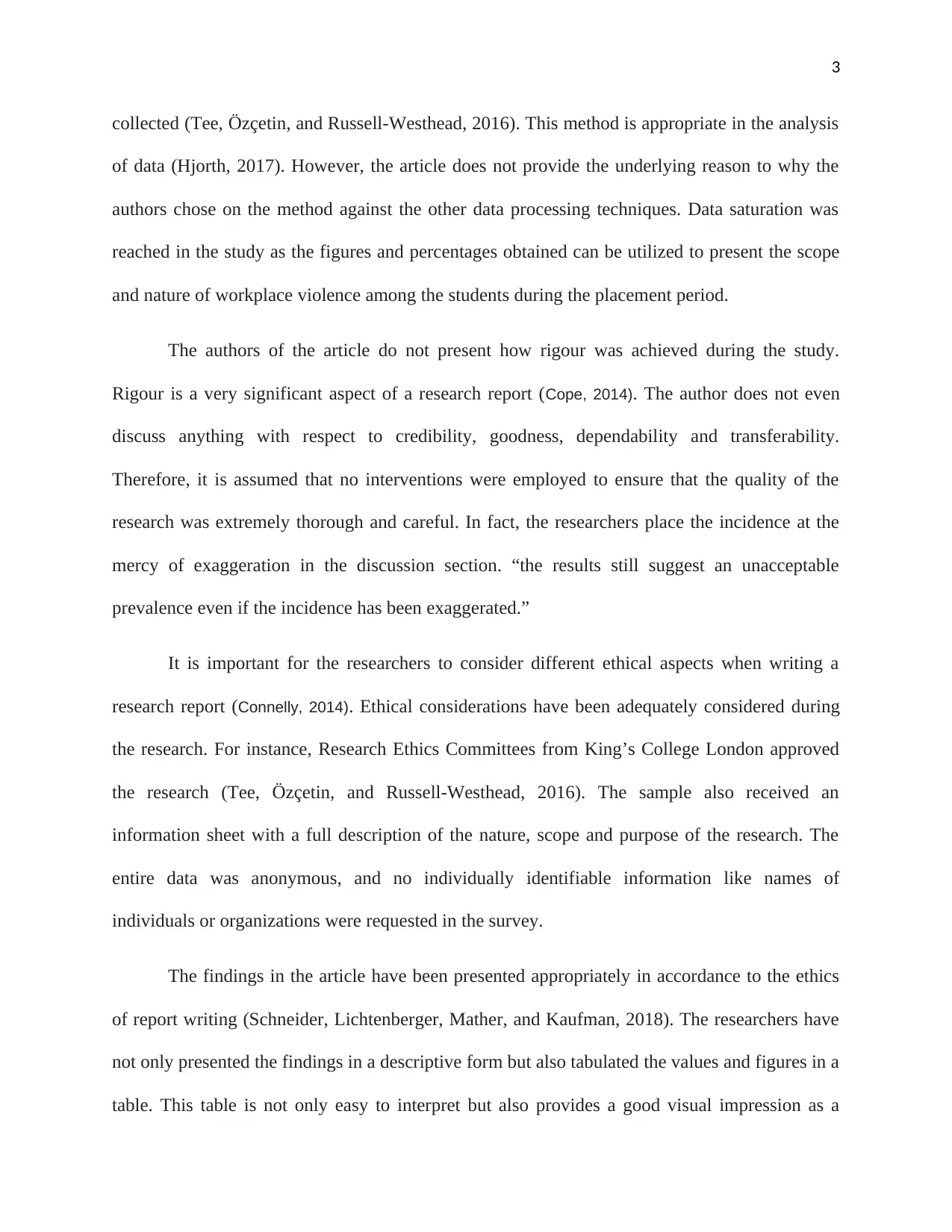
3
collected (Tee, Özçetin, and Russell-Westhead, 2016). This method is appropriate in the analysis
of data (Hjorth, 2017). However, the article does not provide the underlying reason to why the
authors chose on the method against the other data processing techniques. Data saturation was
reached in the study as the figures and percentages obtained can be utilized to present the scope
and nature of workplace violence among the students during the placement period.
The authors of the article do not present how rigour was achieved during the study.
Rigour is a very significant aspect of a research report (Cope, 2014). The author does not even
discuss anything with respect to credibility, goodness, dependability and transferability.
Therefore, it is assumed that no interventions were employed to ensure that the quality of the
research was extremely thorough and careful. In fact, the researchers place the incidence at the
mercy of exaggeration in the discussion section. “the results still suggest an unacceptable
prevalence even if the incidence has been exaggerated.”
It is important for the researchers to consider different ethical aspects when writing a
research report (Connelly, 2014). Ethical considerations have been adequately considered during
the research. For instance, Research Ethics Committees from King’s College London approved
the research (Tee, Özçetin, and Russell-Westhead, 2016). The sample also received an
information sheet with a full description of the nature, scope and purpose of the research. The
entire data was anonymous, and no individually identifiable information like names of
individuals or organizations were requested in the survey.
The findings in the article have been presented appropriately in accordance to the ethics
of report writing (Schneider, Lichtenberger, Mather, and Kaufman, 2018). The researchers have
not only presented the findings in a descriptive form but also tabulated the values and figures in a
table. This table is not only easy to interpret but also provides a good visual impression as a
collected (Tee, Özçetin, and Russell-Westhead, 2016). This method is appropriate in the analysis
of data (Hjorth, 2017). However, the article does not provide the underlying reason to why the
authors chose on the method against the other data processing techniques. Data saturation was
reached in the study as the figures and percentages obtained can be utilized to present the scope
and nature of workplace violence among the students during the placement period.
The authors of the article do not present how rigour was achieved during the study.
Rigour is a very significant aspect of a research report (Cope, 2014). The author does not even
discuss anything with respect to credibility, goodness, dependability and transferability.
Therefore, it is assumed that no interventions were employed to ensure that the quality of the
research was extremely thorough and careful. In fact, the researchers place the incidence at the
mercy of exaggeration in the discussion section. “the results still suggest an unacceptable
prevalence even if the incidence has been exaggerated.”
It is important for the researchers to consider different ethical aspects when writing a
research report (Connelly, 2014). Ethical considerations have been adequately considered during
the research. For instance, Research Ethics Committees from King’s College London approved
the research (Tee, Özçetin, and Russell-Westhead, 2016). The sample also received an
information sheet with a full description of the nature, scope and purpose of the research. The
entire data was anonymous, and no individually identifiable information like names of
individuals or organizations were requested in the survey.
The findings in the article have been presented appropriately in accordance to the ethics
of report writing (Schneider, Lichtenberger, Mather, and Kaufman, 2018). The researchers have
not only presented the findings in a descriptive form but also tabulated the values and figures in a
table. This table is not only easy to interpret but also provides a good visual impression as a
Secure Best Marks with AI Grader
Need help grading? Try our AI Grader for instant feedback on your assignments.
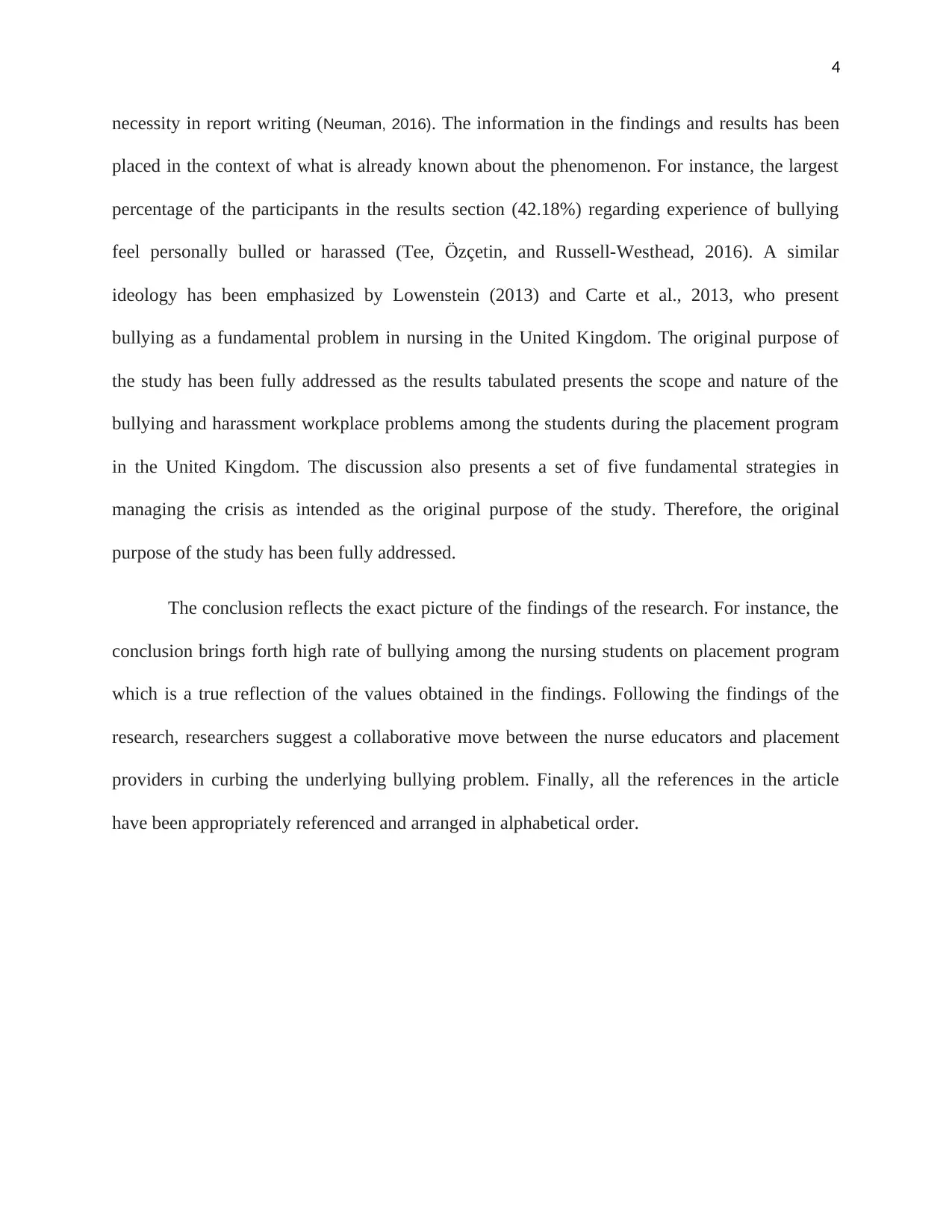
4
necessity in report writing (Neuman, 2016). The information in the findings and results has been
placed in the context of what is already known about the phenomenon. For instance, the largest
percentage of the participants in the results section (42.18%) regarding experience of bullying
feel personally bulled or harassed (Tee, Özçetin, and Russell-Westhead, 2016). A similar
ideology has been emphasized by Lowenstein (2013) and Carte et al., 2013, who present
bullying as a fundamental problem in nursing in the United Kingdom. The original purpose of
the study has been fully addressed as the results tabulated presents the scope and nature of the
bullying and harassment workplace problems among the students during the placement program
in the United Kingdom. The discussion also presents a set of five fundamental strategies in
managing the crisis as intended as the original purpose of the study. Therefore, the original
purpose of the study has been fully addressed.
The conclusion reflects the exact picture of the findings of the research. For instance, the
conclusion brings forth high rate of bullying among the nursing students on placement program
which is a true reflection of the values obtained in the findings. Following the findings of the
research, researchers suggest a collaborative move between the nurse educators and placement
providers in curbing the underlying bullying problem. Finally, all the references in the article
have been appropriately referenced and arranged in alphabetical order.
necessity in report writing (Neuman, 2016). The information in the findings and results has been
placed in the context of what is already known about the phenomenon. For instance, the largest
percentage of the participants in the results section (42.18%) regarding experience of bullying
feel personally bulled or harassed (Tee, Özçetin, and Russell-Westhead, 2016). A similar
ideology has been emphasized by Lowenstein (2013) and Carte et al., 2013, who present
bullying as a fundamental problem in nursing in the United Kingdom. The original purpose of
the study has been fully addressed as the results tabulated presents the scope and nature of the
bullying and harassment workplace problems among the students during the placement program
in the United Kingdom. The discussion also presents a set of five fundamental strategies in
managing the crisis as intended as the original purpose of the study. Therefore, the original
purpose of the study has been fully addressed.
The conclusion reflects the exact picture of the findings of the research. For instance, the
conclusion brings forth high rate of bullying among the nursing students on placement program
which is a true reflection of the values obtained in the findings. Following the findings of the
research, researchers suggest a collaborative move between the nurse educators and placement
providers in curbing the underlying bullying problem. Finally, all the references in the article
have been appropriately referenced and arranged in alphabetical order.
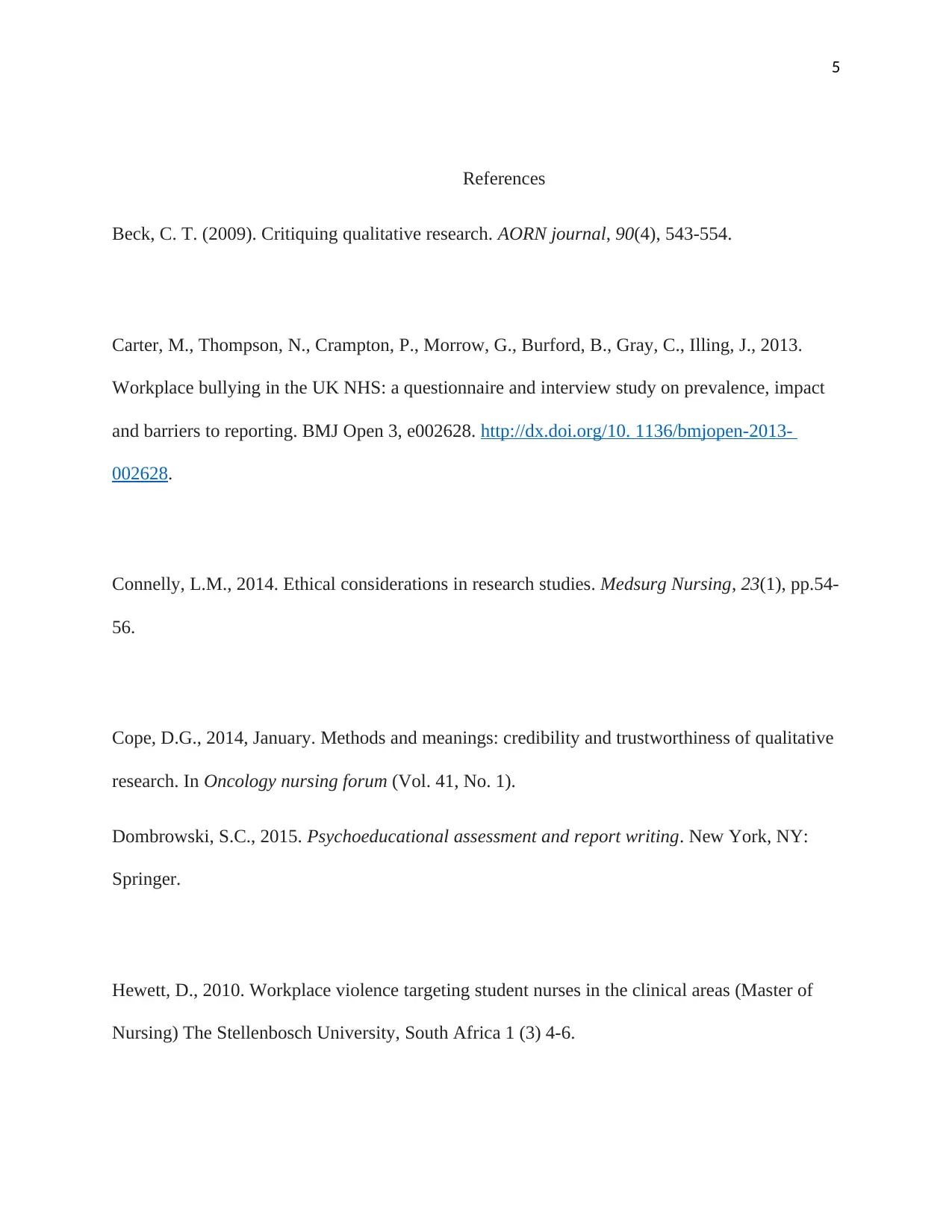
5
References
Beck, C. T. (2009). Critiquing qualitative research. AORN journal, 90(4), 543-554.
Carter, M., Thompson, N., Crampton, P., Morrow, G., Burford, B., Gray, C., Illing, J., 2013.
Workplace bullying in the UK NHS: a questionnaire and interview study on prevalence, impact
and barriers to reporting. BMJ Open 3, e002628. http://dx.doi.org/10. 1136/bmjopen-2013-
002628.
Connelly, L.M., 2014. Ethical considerations in research studies. Medsurg Nursing, 23(1), pp.54-
56.
Cope, D.G., 2014, January. Methods and meanings: credibility and trustworthiness of qualitative
research. In Oncology nursing forum (Vol. 41, No. 1).
Dombrowski, S.C., 2015. Psychoeducational assessment and report writing. New York, NY:
Springer.
Hewett, D., 2010. Workplace violence targeting student nurses in the clinical areas (Master of
Nursing) The Stellenbosch University, South Africa 1 (3) 4-6.
References
Beck, C. T. (2009). Critiquing qualitative research. AORN journal, 90(4), 543-554.
Carter, M., Thompson, N., Crampton, P., Morrow, G., Burford, B., Gray, C., Illing, J., 2013.
Workplace bullying in the UK NHS: a questionnaire and interview study on prevalence, impact
and barriers to reporting. BMJ Open 3, e002628. http://dx.doi.org/10. 1136/bmjopen-2013-
002628.
Connelly, L.M., 2014. Ethical considerations in research studies. Medsurg Nursing, 23(1), pp.54-
56.
Cope, D.G., 2014, January. Methods and meanings: credibility and trustworthiness of qualitative
research. In Oncology nursing forum (Vol. 41, No. 1).
Dombrowski, S.C., 2015. Psychoeducational assessment and report writing. New York, NY:
Springer.
Hewett, D., 2010. Workplace violence targeting student nurses in the clinical areas (Master of
Nursing) The Stellenbosch University, South Africa 1 (3) 4-6.
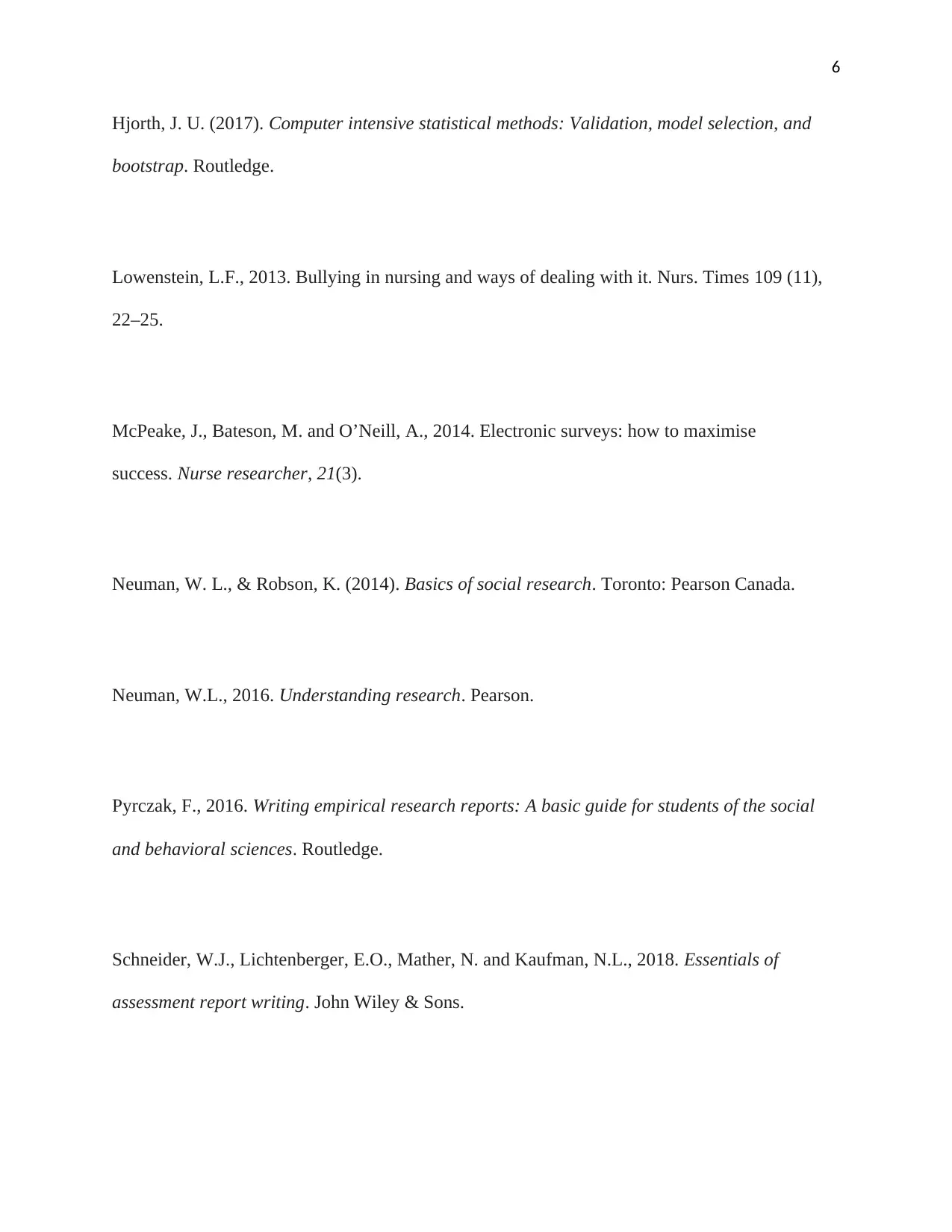
6
Hjorth, J. U. (2017). Computer intensive statistical methods: Validation, model selection, and
bootstrap. Routledge.
Lowenstein, L.F., 2013. Bullying in nursing and ways of dealing with it. Nurs. Times 109 (11),
22–25.
McPeake, J., Bateson, M. and O’Neill, A., 2014. Electronic surveys: how to maximise
success. Nurse researcher, 21(3).
Neuman, W. L., & Robson, K. (2014). Basics of social research. Toronto: Pearson Canada.
Neuman, W.L., 2016. Understanding research. Pearson.
Pyrczak, F., 2016. Writing empirical research reports: A basic guide for students of the social
and behavioral sciences. Routledge.
Schneider, W.J., Lichtenberger, E.O., Mather, N. and Kaufman, N.L., 2018. Essentials of
assessment report writing. John Wiley & Sons.
Hjorth, J. U. (2017). Computer intensive statistical methods: Validation, model selection, and
bootstrap. Routledge.
Lowenstein, L.F., 2013. Bullying in nursing and ways of dealing with it. Nurs. Times 109 (11),
22–25.
McPeake, J., Bateson, M. and O’Neill, A., 2014. Electronic surveys: how to maximise
success. Nurse researcher, 21(3).
Neuman, W. L., & Robson, K. (2014). Basics of social research. Toronto: Pearson Canada.
Neuman, W.L., 2016. Understanding research. Pearson.
Pyrczak, F., 2016. Writing empirical research reports: A basic guide for students of the social
and behavioral sciences. Routledge.
Schneider, W.J., Lichtenberger, E.O., Mather, N. and Kaufman, N.L., 2018. Essentials of
assessment report writing. John Wiley & Sons.
Paraphrase This Document
Need a fresh take? Get an instant paraphrase of this document with our AI Paraphraser
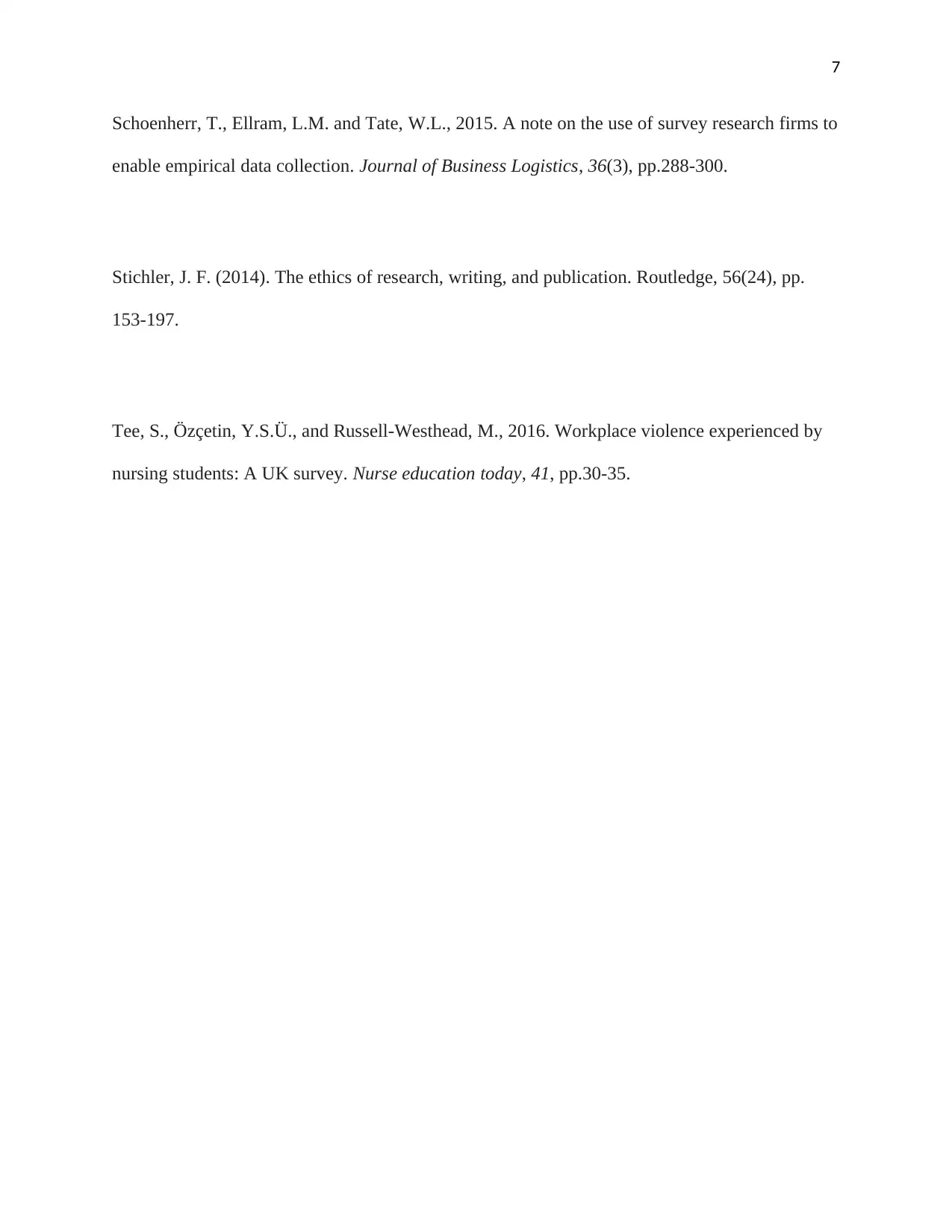
7
Schoenherr, T., Ellram, L.M. and Tate, W.L., 2015. A note on the use of survey research firms to
enable empirical data collection. Journal of Business Logistics, 36(3), pp.288-300.
Stichler, J. F. (2014). The ethics of research, writing, and publication. Routledge, 56(24), pp.
153-197.
Tee, S., Özçetin, Y.S.Ü., and Russell-Westhead, M., 2016. Workplace violence experienced by
nursing students: A UK survey. Nurse education today, 41, pp.30-35.
Schoenherr, T., Ellram, L.M. and Tate, W.L., 2015. A note on the use of survey research firms to
enable empirical data collection. Journal of Business Logistics, 36(3), pp.288-300.
Stichler, J. F. (2014). The ethics of research, writing, and publication. Routledge, 56(24), pp.
153-197.
Tee, S., Özçetin, Y.S.Ü., and Russell-Westhead, M., 2016. Workplace violence experienced by
nursing students: A UK survey. Nurse education today, 41, pp.30-35.
1 out of 8
Related Documents
Your All-in-One AI-Powered Toolkit for Academic Success.
+13062052269
info@desklib.com
Available 24*7 on WhatsApp / Email
![[object Object]](/_next/static/media/star-bottom.7253800d.svg)
Unlock your academic potential
© 2024 | Zucol Services PVT LTD | All rights reserved.





